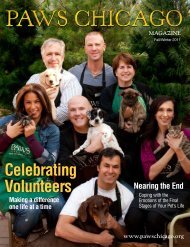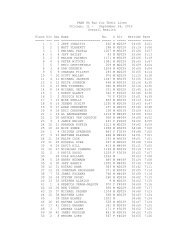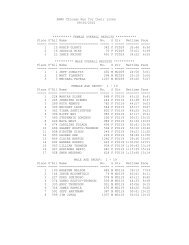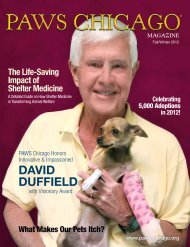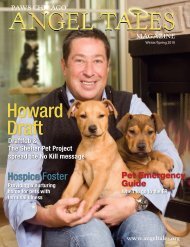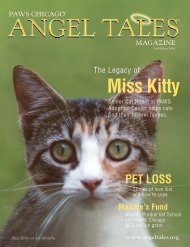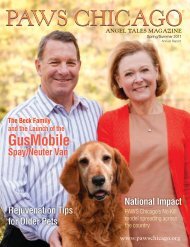Winter 2010 - PAWS Chicago
Winter 2010 - PAWS Chicago
Winter 2010 - PAWS Chicago
You also want an ePaper? Increase the reach of your titles
YUMPU automatically turns print PDFs into web optimized ePapers that Google loves.
A Guide to<br />
Pet Dental<br />
Care<br />
The gnawing concerns from<br />
owners about veterinary<br />
dental hygiene.<br />
By Dr. Barbara Royal, DVM<br />
QCan you clean an animal’s teeth without anesthesia • If a tooth is broken, does it have to<br />
be removed • Isn’t bad dog breath unavoidable • Which is safer: rawhides, compressed<br />
vegetable chew treats, synthetic bones, cooked bones, raw bones, or none of the above •<br />
Why do some dogs have more tartar than others • Do I really need to brush my dog’s teeth –<br />
and for heaven’s sake, chicken flavored toothpaste – ugh! • What about dry food<br />
What do you think of when you think<br />
about dental tartar and dental disease in<br />
your pet Maybe bad breath or trouble<br />
chewing, but usually we don’t link dental<br />
disease with any serious health risks.<br />
Unfortunately, this assumption is<br />
not true. Indeed, dental disease can<br />
contribute to serious health problems.<br />
These include heart and lung disease,<br />
diabetes, gastrointestinal problems,<br />
kidney disease, leukemia, cancers,<br />
abscesses and gum disease. So clearly it’s<br />
not just about a pretty smile. Dental care<br />
is important to systemic health.<br />
Many pet owners are nervous about<br />
doing a dental cleaning because of the<br />
risks associated with anesthesia. This<br />
is a valid concern, but at the same time,<br />
many animals need to have the full<br />
anesthetic procedure to properly clean<br />
the teeth under the gums and maybe to<br />
do extractions and/or treat cavities.<br />
What is possible without anesthesia<br />
With a proper assessment and a<br />
good temperament (both animal and<br />
veterinary), it is possible to chip off tartar<br />
and polish teeth while they are awake.<br />
Is a dental cleaning without<br />
anesthesia a good idea<br />
It is certainly not perfect. But where<br />
animals have an otherwise healthy<br />
mouth and willing temperament, it may<br />
be worth doing to avoid the risks of<br />
anesthesia. Non-anesthesia dentals can<br />
still significantly improve breath, dental<br />
condition and overall health.<br />
It’s difficult to fully clean under the<br />
gums with an awake animal. And clearly<br />
no extractions or dental radiographs are<br />
possible. But a lot can be done without<br />
anesthesia. And sometimes, in animals<br />
that cannot tolerate anesthesia, cleaning<br />
the teeth this way may be a useful<br />
alternative.<br />
At my practice, after a careful<br />
dental assessment by the veterinarian,<br />
we schedule an hour-long cleaning<br />
appointment, and have extra staff<br />
available to help calm and hold up the<br />
lips. With calm pets, we often clean all<br />
the teeth in one appointment. Some<br />
animals need a break and we schedule<br />
several shorter visits. After removing the<br />
tartar, we can then polish the teeth with a<br />
pumice and gauze to help keep the tartar<br />
from returning.<br />
There is always the risk, after chipping<br />
off tartar, of finding something more<br />
sinister below, requiring anesthesia to<br />
repair or remove. But if you are prepared<br />
for that possibility, it is reasonable to try.<br />
Once teeth are clean, you can keep them<br />
that way by brushing. It’s even helpful if<br />
you can only get to it a few times a week<br />
(I know how hard it is to keep up on<br />
every day pet toothbrushing.)<br />
Dental disease is also affected by<br />
genetics, chewing behavior, nutrition,<br />
systemic disease, treats, and even stress.<br />
Not every dog is born with a perfect<br />
set of teeth or an even bite. Many dogs<br />
are also born with a tendency to harbor<br />
bacteria that is more prone to produce<br />
tartar.<br />
Continued on page 36<br />
35



